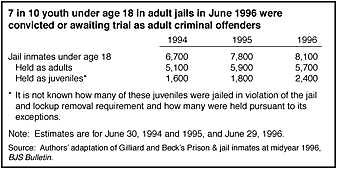|
In 1996 the one-day count of youth under age 18 held in local adult jails was 8,100

The number of youth under 18 in jails rose 20% from 1994 to 1996
According to the Bureau of Justice Statistics' Annual Survey of Jails, an estimated 8,100 youth under the age of 18 were held in adult jails on June 29, 1996 -- about 2% of the total jail population. The one-day count of under-18 jail inmates in 1996 was 4% greater than the figure a year earlier and over 20% greater than the 1994 figure. The majority of youth under age 18 held in adult jails were held as adults. Although they account for a smaller proportion of under-18 jail inmates, the number of inmates under 18 who were being held as juveniles rose 50% from 1994 to 1996. In comparison, the overall one-day count of jail inmates grew 7% from 1994 to 1996.
Prior to 1994 the Annual Survey of Jails counted the number of jail inmates initially subject to juvenile court authority as juvenile offenders even if they were tried as adults in criminal court. In 1985 an estimated 1,630 such juveniles were held in adult jails. By 1992 the estimate had risen to 2,800.
| Recent rules change the Juvenile Justice and Delinquency Prevention Act jail removal requirement
Regulations effective December 10, 1996, modify Juvenile Justice and Delinquency Prevention Act requirements in several ways:
- Clarify the sight and sound separation requirement and provide that brief and inadvertent or accidental contact in nonresidential areas is not a reportable violation.
- Permit time-phased use of program areas in collocated facilities.
- Expand the 6-hour hold exception to include 6 hours before and after court appearances.
- Allow adjudicated delinquents to be transferred to adult institutions once they have reached the State's age of full criminal responsibility where such transfer is expressly authorized or required by State law.
The revised regulations are intended to offer flexibility to States in carrying out the Act's requirements.
|
|
| The Juvenile Justice and Delinquency Prevention Act limits the placement of juveniles in adult facilities
The Act states that, " . . . juveniles alleged to be or found to be delinquent and [status offenders and nonoffenders] shall not be detained or confined in any institution in which they have contact with adult[s] incarcerated because they have been convicted of a crime or are awaiting trial on criminal charges..." This part of the Act is commonly referred to as the "jail removal requirement."
Regulations implementing the Act exempt juveniles held in secure adult facilities if the juvenile is being tried as a criminal for a felony or has been convicted as a criminal felon. In institutions other than adult jails or lockups, confinement is permitted if the juvenile and adult inmates cannot see each other and no conversation between them is possible.
This latter requirement is commonly referred to as "sight and sound separation." There is a 6-hour grace period that allows adult jails and lockups to hold alleged delinquents in secure custody until other arrangements can be made. Jails and lockups in rural areas may hold delinquents up to 24 hours, exclusive of weekends and holidays, under certain conditions.
Some jurisdictions have established juvenile detention centers that are collocated with adult jail facilities or lockups. A collocated juvenile detention facility must meet specific criteria to establish that it is a separate and distinct facility.
|
|
|